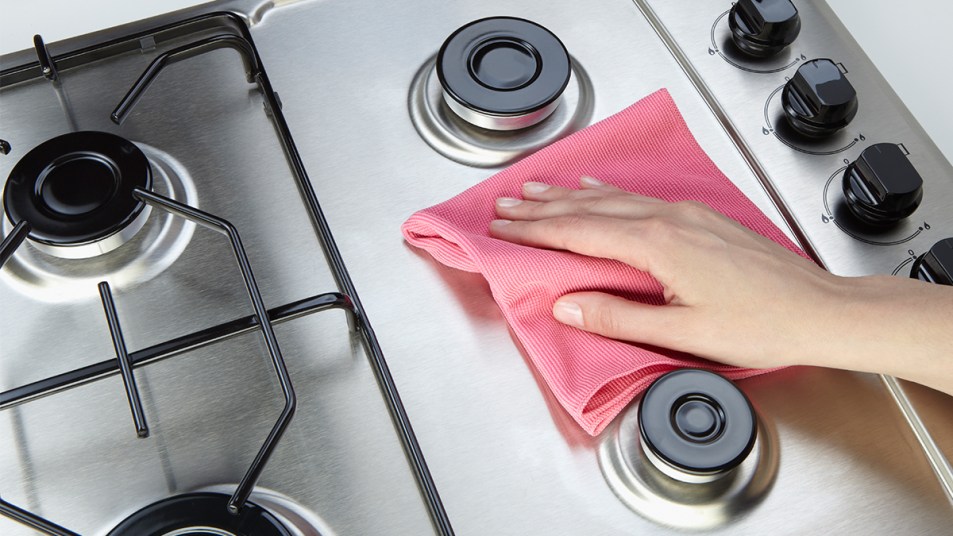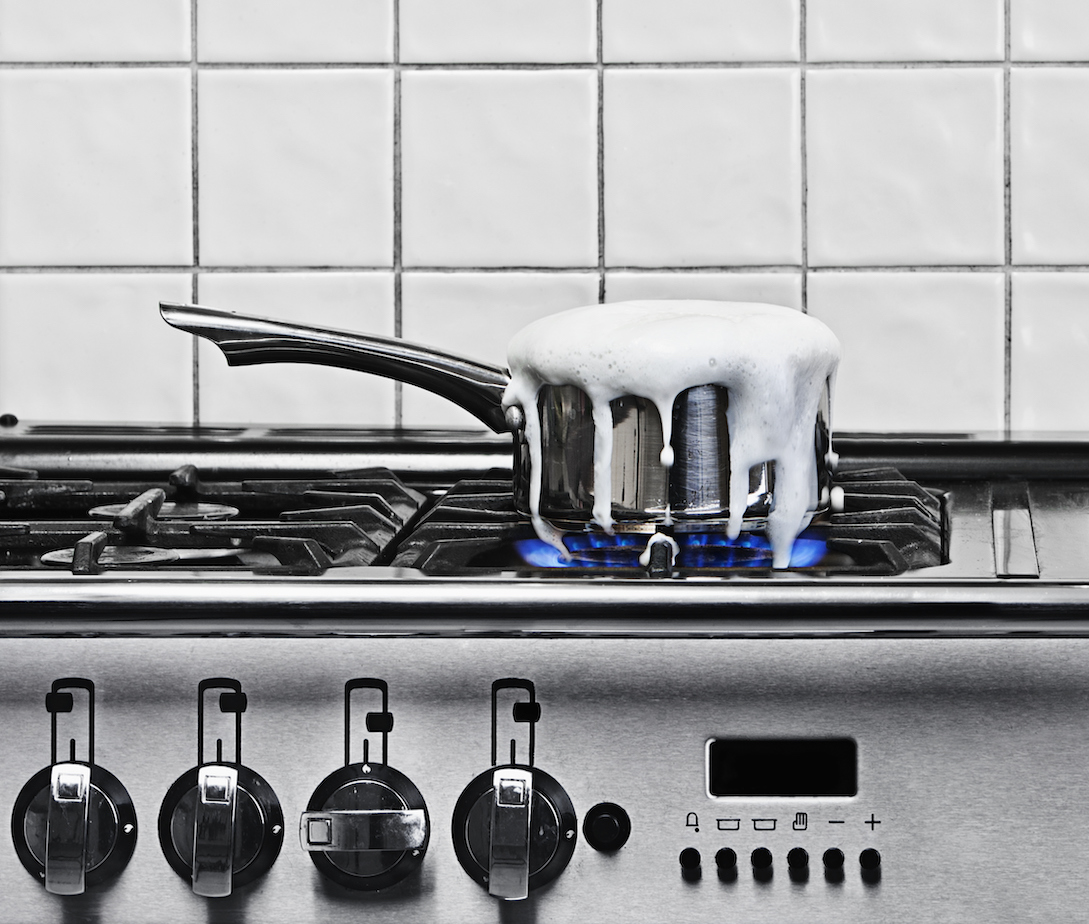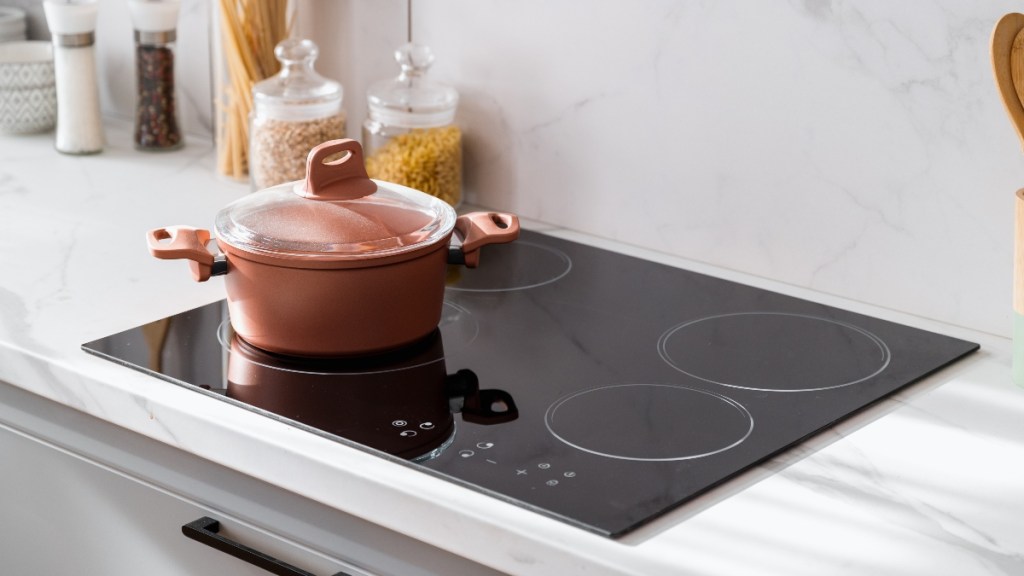Cleaning Pro’s Genius No-Scrub Hacks to Clean Gas Stove Burners, Grates & Heads
We wish we had learned this easy grate-cleaning tip years ago!

Whether you’re a pro at whipping up soups or making pasta is about as skilled as you get in the kitchen, chances are you’ve made a mess on your stove top. Spills, boil-overs, greasy pots and more can leave the surface covered in tough-to-remove grime, but even worse when it seeps down below the grates and into the burners. Not only does it make cleaning the stove top a dreaded chore, but dirty gas burners can cause uneven flames which can lead to burned or oddly cooked food. The key to getting it clean, no elbow-grease required: using simple tools and common household items! So we asked cleaning pros how to clean gas stove burners, grates stove tops and more with ease.
How to clean gas stove burners, caps and more

Before tackling the burners, the one spot on a gas stovetop that gets especially dirty that seem most intimidating? The grates. And experts agree, it’s best to start there.
How to clean gas stove burner grates: an ammonia soak
Any grime on your pots and pans can drip onto the grates and become quite tough to eliminate. But, there’s a surprise way to remove the grime, no scrubbing needed: let ammonia do the work for you! “Simply remove the grimy grates, pop each one in a plastic bag, then pour in 2 cups of ammonia and tie tightly,” says Bailey Carson, home care expert at Angi. Because of ammonia’s strong odor and fumes you’ll want to let the bags sit outside or in your garage overnight to ensure proper ventilation.
“In the morning, empty them in your sink, give the grates a quick rinse and watch in amazement as the grime washes right off!” says Carson.
How to clean gas stove burner caps: a hot soapy bath
Besides the grates, when cleaning gas stove burners, you’ll want to ensure the stovetop caps (the part that covers the burners) get special attention, as well. Soaking them in a sink or bowl of hot soapy water for 10 minutes will soften grime so you can scrub them clean with a microfiber cloth.
How to clean gas stove burner heads: use a paper clip
Once you’ve cleaned the caps, you’ll want to ensure the gas burner heads get a good once-over since debris, blocked air flow, or a clogged orifice (where the gas comes out) can prevent ignition or even cause uneven flames. Carefully lift the burner head straight up, then use a paper clip or the metal wire from a twist tie to clean any debris from the grooves, advises Carson. You can also use a paper clip to remove any grime from the opening of the actual burner.
See it on action in this YouTube video:
For the rest of this small area, there are two often overlooked essentials that can make cleaning a breeze: a microfiber cloth and a plastic razor blade (like Tool Shop Plastic Razor Blades, buy from Menards, $1.33 for a 10-pack). “The microfiber efficiently cleans and traps debris gently, while the plastic razor blade excels at getting under/lifting burnt-on food without causing harm to the stovetop,” says Katrina Keith, owner at the Molly Maid of Dallas-Fort Worth Metro Northwest.
How to clean a gas stove top surface: this simple paste
“To tackle stubborn build-up, consider making an eco-scouring paste using four tablespoons of baking soda, a sprinkle of salt and two tablespoons of water,” adds Keith. “Apply the paste to anywhere with build-up, allowing it to sit for 10 minutes before scrubbing with an old toothbrush.”
Baking soda reacts with cooked-on grease to remove it while the abrasive salt helps to scrub away grime.
How to clean electric stove tops

Electric stovetops are generally made of ceramic or glass, and they can get covered in their fair share of caked-on grime too.
The must-have for getting the surface clean? “I always bring The Pink Stuff (Buy from Amazon, $5.97) with me on cleans because of its all-around use plus it also works as a degreaser,” says Maria Zarate, a cleaning pro at BetterCleans. (Note: Make sure to remove burners if there are any before cleaning.) And Zarate is not alone, users on TikTok, YouTube and Instagram have proclaimed the pink paste to be a miracle cleaner. One smart way to really scrub the electric stovetop clean? Pair the Pink Stuff with a Scrub Daddy.
This YouTube shows the easy how-to:
For deeper cleans, Zarate recommends a DIY mix of equal parts vinegar and water in a spray bottle. “Spray it on any tough spots or spills and give it a few minutes, at least 15 to 30 minutes,” adds Zarate. “Use a cloth or paper towel to gently scrub your stovetop in circles or back-and-forth.”
If you come across any food stains, simply place a cloth dampened with the vinegar mix onto the spot and let sit for at least 15 minutes. The acids in the vinegar will work to dissolve stuck-on food so all you have to do is wipe with a soft cloth. (Click through for more white vinegar uses.)
Then to wipe down any residue for a streak-free finish, enlist a squeegee! It will leave the surface sparkling just like it does for a window or glass shower door. See it in action in the TikTok below:
@cleanwithnessa Ever tried a squeegee on a stove top 🤔 #satisfying #clean #cleaning #cleanwithnessa 
♬ Iko Iko (My Bestie) (feat. Small Jam) – Justin Wellington
What *not* to use to clean a stovetop
Regardless of what type of stove top you have, there are a few things you’ll want to steer clear of to avoid causing damage.
1. When you end up with a mess on your stovetop, it may be tempting to clean it right away, but the pros caution against it.
“Trying to wipe away food debris while still fresh can make things worse,” says Keith. “It’s best to wait for the stove to fully cool to ensure messes are easy to scrape up and to avoid the risk of burning yourself or your cleaning equipment,”
2. Avoid harsh chemicals and abrasive cleaners, which can do more harm than good!
“Some people use a durafoam sponge for extremely tough burn marks – these can work, but please use cautiously as this substance is like a micro-fine sandpaper and can scratch the surface if you’re not careful,” says Keith.
3. For gas stovetops, you’ll want to be careful not to use too much water when you clean them. The reason: If you get the spark electrode wet, it will continuously try and ignite the gas and make a clicking noise. “Most times this can be resolved easily by disconnecting the power and allowing the ignitors to dry,” adds Keith.
For more stove cleaning hacks, keep reading!
How to Clean an Oven Quickly and Painlessly
This Homemade Oven Cleaner Made With Dawn Is the Life-Simplifier You Need Now

















